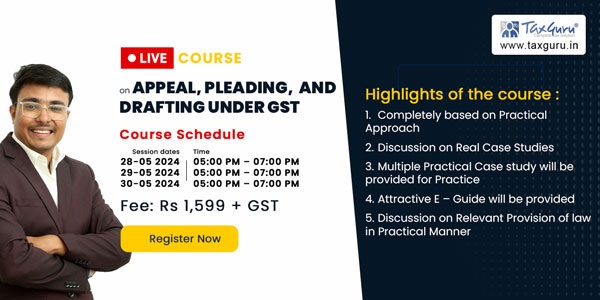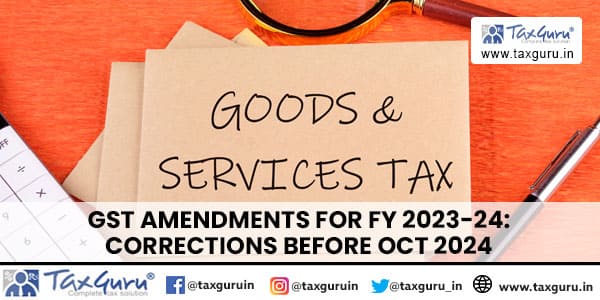Case Law Details
A Division Bench of this Court in Commissioner of Income-tax v. Rewashanker A. Kothari (2006) 283 ITR 338 (Guj.) has laid down the following test for determining the question as to whether an assessee can be said to be carrying on business. Such tests laid down by this Court are reproduced below:-
“[a] The first test is whether the initial acquisition of the subject matter of transaction was with the intention of dealing in the item, or with a view to finding an investment. If the transaction, since the inception, appears to be impressed with the character of a commercial transaction entered into with a view to earn profit, it would furnish a valuable guideline.
[b] The second test that is often applied is as to why and how and for what purpose the sale was effected subsequently.
[c] The third test, which is frequently applied, is as to how the assessee dealt with the subject matter of transaction during the time the asset was with the assessee. Has it been treated as stock-in-trade, or has it been shown in the books of account and balance sheet as an investment. This inquiry, though relevant, is not conclusive.
[d] The fourth test is as to how the assessee himself has returned the income from such activities and how the department has dealt with the same in the course of preceding and succeeding assessments. This factor, though not conclusive, can afford good and cogent evidence to judge the nature of transaction and would be a relevant circumstance to be considered in absence of any satisfactory explanation.
[e] The fifth test, normally applied in cases of partnership firms and companies, is whether the Deed of Partnership or the Memorandum of Association, as the case may be, authorises such an activity.
[f] The last but not the least, rather the most important test, is as to the volume, frequency, continuity and regularity of transactions of purchase and sale of the goods concerned. In a case where there is repetition and continuity, coupled with the magnitude of the transaction, bearing reasonable proportion to the strength of holding, then an inference can readily be drawn that the activity is in the nature of business.”
In view of the aforesaid decisions of the Apex Court as well as of this Court, it is clear that where number of transactions of sale and purchase of shares takes place, the most important test is the volume, frequency, continuity and regularity of transactions of purchase and sale of the shares. However, where there is repetition and continuity, coupled with magnitude of the transaction, bearing reasonable proportion to the strength of holding, then an inference can be drawn that activity is in the nature of business. Learned counsel for the revenue from the records could not demonstrate that there were large number of transactions which had frequency, volume, continuity and regularity and fell within the tests laid down by the Division Bench of this Court.
For the aforesaid reasons, we are of the considered opinion that the income earned by the assessee from trading in the shares under the head long term capital gain / short term capital gain was correctly shown. We do not find that in the Assessment Year 2005-2006 and 2006-2007, the transaction of sale of shares and volume were substantial.
IN THE HIGH COURT OF GUJARAT AT AHMEDABAD
TAX APPEAL No. 77 of 2010 WITH
TAX APPEAL No. 78 of 2010
COMMISSIONER OF INCOME TAX
Versus
VAIBHAV J SHAH (HUF)
Date : 27/06/2012
COMMON ORAL JUDGMENT
(Per: HONOURABLE MR.JUSTICE V. M. SAHAI)
1. Both these Tax Appeals have been filed challenging the order dated 17.9.2009 passed by the Income Tax Appellate Tribunal and the order dated 27.5.2008 passed by the Commissioner of Income Tax (Appeals).
2. We have heard learned Standing counsel Mrs. Paurami Sheth appearing for the revenue in these two Tax Appeals. Inspite of service, nobody appears for the respondent.
3. The following substantial question of law arises for the consideration of this Court:-
“Whether the Appellate Tribunal is right in law and on facts in confirming the order passed by CIT (A) in directing to tax the income earned from trading in shares under the head ‘LTCG/STCG’ as shown by the assessee instead of taxing it under the head ‘Income From Business & Profession’ ?”
4. A notice was issued under Section 1 53C of the Income Tax Act (for short ‘the Act’) on the basis of communication received by the Assessing Officer from the DGIT, Ahmedabad. In response to the notice, returns of income were filed by the assessee for the Assessment Years 2001-02 to 2006-07. According to the Assessing Officer, the assessee as well as his close relations were dealing heavily in shares. The Assessing Officer was of the view that on the basis of involvement of the family members of the assessee and looking to the frequency and magnitude and other relevant factors, the assessee should be held to be dealing in shares and his income should be treated from business and not as long term / short term capital gains as declared by the assessee. The Assessing Officer passed an assessment order under Section 1 53A read with Section 143 (3) of the Act treating the income shown by the assessee as income from business and made addition to the total income in the respective years accordingly. In appeal filed by the assessee, the Commissioner of Income Tax (Appeals) deleted the additions made by the Assessing Officer.
5. We have gone through the record. We find that the Commissioner of Income-tax (Appeals) and the Appellate Tribunal both have held in favour of the assessee and against the revenue by recording a finding of fact that the assessee had rightly claimed his income earned from trading in shares under the head long term capital gains / short term capital gains. However, with regard to the same assessee, for the Assessment Years 2000–2001 to 2004–2005, a Division Bench of this Court in Tax Appeal No.48 of 2010 and cognate appeals had affirmed the finding of the Tribunal and had dismissed the appeals. However, the question with regard to assessment Year 2005–2006 and 2006–2007 were left open as according to the Department, large number of transactions took place which required separate consideration. Both these Tax Appeal relate to the Assessment Years 2005–2006 and 2006–2007 respectively.
6. The Apex Court in Commissioner of Income-Tax (Central) Calcutta v. Associated Industrial Development Company (P) Limited, 82 ITR 586 (SC) has observed as under :-
“Whether a particular holding of shares is by way of investment or forms part of the stock-in-trade is a matter which is within the knowledge of the assessee who holds the shares and it should, in normal circumstances, be in a position to produce evidence from its records as to whether it has maintained any distinction between those shares which are stock-in-trade and those which are held by way of investment.”
7. The Apex Court in another decision in Commissioner of Income Tax, Bombay v. H. Holck Larsen, 160 ITR 67 (SC), the Apex Court has held as under :-
“The High Court, in our opinion, made a mistake in observing whether transactions of sale and purchase of shares were trading transactions or whether these were in the nature of investment was question of law. This was a mixed question of law and fact.”
8. A Division Bench of this Court in Commissioner of Income-tax v. Rewashanker A. Kothari (2006) 283 ITR 338 (Guj.) has laid down the following test for determining the question as to whether an assessee can be said to be carrying on business. Such tests laid down by this Court are reproduced below:-
“[a] The first test is whether the initial acquisition of the subject matter of transaction was with the intention of dealing in the item, or with a view to finding an investment. If the transaction, since the inception, appears to be impressed with the character of a commercial transaction entered into with a view to earn profit, it would furnish a valuable guideline.
[b] The second test that is often applied is as to why and how and for what purpose the sale was effected subsequently.
[c] The third test, which is frequently applied, is as to how the assessee dealt with the subject matter of transaction during the time the asset was with the assessee. Has it been treated as stock-in-trade, or has it been shown in the books of account and balance sheet as an investment. This inquiry, though relevant, is not conclusive.
[d] The fourth test is as to how the assessee himself has returned the income from such activities and how the department has dealt with the same in the course of preceding and succeeding assessments. This factor, though not conclusive, can afford good and cogent evidence to judge the nature of transaction and would be a relevant circumstance to be considered in absence of any satisfactory explanation.
[e] The fifth test, normally applied in cases of partnership firms and companies, is whether the Deed of Partnership or the Memorandum of Association, as the case may be, authorises such an activity.
[f] The last but not the least, rather the most important test, is as to the volume, frequency, continuity and regularity of transactions of purchase and sale of the goods concerned. In a case where there is repetition and continuity, coupled with the magnitude of the transaction, bearing reasonable proportion to the strength of holding, then an inference can readily be drawn that the activity is in the nature of business.”
9. In view of the aforesaid decisions of the Apex Court as well as of this Court, it is clear that where number of transactions of sale and purchase of shares takes place, the most important test is the volume, frequency, continuity and regularity of transactions of purchase and sale of the shares. However, where there is repetition and continuity, coupled with magnitude of the transaction, bearing reasonable proportion to the strength of holding, then an inference can be drawn that activity is in the nature of business. Learned counsel for the revenue from the records could not demonstrate that there were large number of transactions which had frequency, volume, continuity and regularity and fell within the tests laid down by the Division Bench of this Court.
10. For the aforesaid reasons, we are of the considered opinion that the income earned by the assessee from trading in the shares under the head long term capital gain / short term capital gain was correctly shown. We do not find that in the Assessment Year 2005-2006 and 2006-2007, the transaction of sale of shares and volume were substantial. We do not find any error or irregularity in the impugned order passed by the Tribunal. The substantial question of law framed by this Court as mentioned above is answered in the affirmative and against the revenue. Both these Tax Appeals are accordingly dismissed.

























